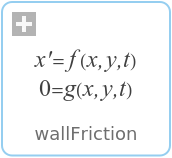WOLFRAM SYSTEM MODELER
wallFrictionReturn pressure loss data due to friction in a straight pipe with walls of nonuniform roughness (not useful for smooth pipes, since zeta is no function of Re) |
|
Wolfram Language

SystemModel["Modelica.Fluid.Fittings.BaseClasses.QuadraticTurbulent.LossFactorData.wallFriction"]

Information
This information is part of the Modelica Standard Library maintained by the Modelica Association.
Friction in straight pipe with walls of nonuniform roughness (commercial pipes) in the region that does not depend on the Reynolds-number
The loss factors are given for mass flow rates from port_a to port_b as:
turbulent flow (Idelchik 1994, diagram 2-5, p. 117) zeta = (L/D)/(2*lg(3.7 / Δ))^2, for Re >= 560/Δ for Re ≥ 560/Δ the loss factor does not depend on the Reynolds number. For Re ≥ 4000, the flow is turbulent, but depends both on Δ and slightly on Re. laminar flow (Idelchik 1994, diagram 2-1, p. 110): zeta = 64*(L/D)/Re
where
- D is the inner pipe diameter
- L is the length of the pipe
- Δ = δ/D is the relative roughness where δ is the absolute "roughness", i.e., the averaged height of asperities in the pipe. (δ may change over time due to growth of surface asperities during service, see [Idelchik 1994, p. 85, Tables 2-1, 2-2]).
Since the LossFactorData record can only describe loss factors that depend on geometry (but, e.g., not on the Reynolds number), only the region with Re ≥ 560/Δ is described by this data. Still, the turbulent region with the above zeta is defined to start at Re=4000, since otherwise the approximation for Re < 560/Δ is too bad.
The absolute roughness δ has usually to be estimated. In [Idelchik 1994, pp. 105-109, Table 2-5; Miller 1990, p. 190, Table 8-1] many examples are given. As a short summary:
| Smooth pipes | Drawn brass, copper, aluminium, glass, etc. | δ = 0.0025 mm |
| Steel pipes | New smooth pipes | δ = 0.025 mm |
| Mortar lined, average finish | δ = 0.1 mm | |
| Heavy rust | δ = 1 mm | |
| Concrete pipes | Steel forms, first class workmanship | δ = 0.025 mm |
| Steel forms, average workmanship | δ = 0.1 mm | |
| Block linings | δ = 1 mm |
Syntax
Inputs (3)
Outputs (1)
| data |
Type: LossFactorData Description: Pressure loss factors for both flow directions |
|---|
